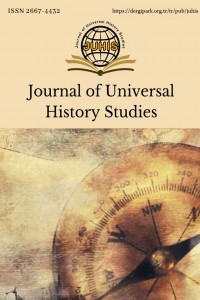Kerman’daki Malik Camii’nin Durumunun Analizi ve Selçuklu Mimarisinin Restorasyonunun Gerekliliği
Kirman’daki Selçuklu Devleti (433-583), İranlı araştırmacı ve bilim insanları tarafından üzerinde az çalışılan ve araştırılan hükümetlerdendir. Bu, bu hanedanlık üzerine yapılan Farsça çalışmaların küçük bir yansımasıyla bulunabilir. Bu hükümetlerin kültürel ve medeni koşulları ve bu kültürde var olan unsurlar, araştırmacıyı, siyasi tarihin basit bir tanımlaması ve ifadesinin ötesinde, kültürel unsurların nasıl girdiğini, nedenlerini,nasıl olduğunu ve Selçuklu mimarisinin Kirman’da nasıl yüceltilebileceğini analiz etmek ve açıklamak için adım atmaya ikna eder. Şüphesiz, Kirman Selçuklu hükümetinin temel kültürel ve gelişim sembollerinden biri de Turanşah Camii'dir (Melek Camii). Bu sebeple, bu çalışmada, ilk olarak Selçuklu hükümetinin Kirman'da nasıl kurulduğu ve ikinci ve en önemli aşamada Melek Camii'nin nasıl inşa edildiği ve durumunun nasıl olduğu açıklanmaya çalışılmıştır. Bu nedenle, asıl sorular: Melek Camii'nin şu anki durumu nasıl? Bu yüzden, asıl sorular: Melek Camii'nin şu anki durumu nasıl? Ve yeni şehircilik fiziksel alanını nasıl etkiler? Bu çalışmanın sonuçları, bu caminin Selçuklular döneminde inşa edildiğini ve Selçuklular dönemindeki diğer mimari anıtlar gibi, çok güçlü ve güzel olduğunu göstermiştir. Birçok güzelliğine rağmen, bugün, binaya daha az dikkat edilmekte ve daha iyi muhafaza edilmesi ve restorasyonu gerekli gözükmektedir.
Anahtar Kelimeler:
Kirman, Selçuklu, Melek Camii, Şehircilik, Mimari, Restorasyon
Analysis Of The Situation Of Malek Mosque In Kerman And The Necessity Of Restoration Of This Seljuq Building
The Seljuq government of Kerman (433-583 A.H. / 1042-1188 A.D.) is of the governments less studied and researched by Iranian researchers and scholars and this can be found in a small reflection on Persian studies on this dynasty. While the cultural and civil conditions of this governments and the elements existing in this culture convince the researcher to take a step, beyond a simple identification and expression of political history, to analyze and explain how these cultural elements entered and what the reasons were and how can the Seljuq architecture be exalted in Kerman. Undoubtedly, one of the main cultural and developmental symbols of the Seljuk government of Kerman is the Turānshah Mosque (the Malek Mosque). Therefore, in the present study, it is tried to firstly explain how the Seljuq government was formed in Kerman and at the second and most important stage, to explain how Malek Mosque was constructed and how its situation is. Therefore, the main questions are: how is the current situation of Malek Mosque? And how does new urbanism affect its physical space? The results of the present study shows that this mosque has been constructed in the Seljuq era and like other architectural monuments of the Seljuq era, it has a lot of strength and beauties. In spite of its many beauties, today, the building is less paid attention and needs to be maintained better and restoration of it seems essential.
Keywords:
Kerman, Seljuq, Malek mosque, Urbanism, Architecture,
___
- [1] Ibn Athir, E. (1984). Full History of Islam and Iran. Offside: Iranian Books Press.
- [2] Bosworth, Clifford Edmund et al. (2001). The Seljuq Dynasty, Azhand Y., Offside: Moses.
- [3] Boyle, J.A. (2001). History of Iran Cambridge (From the coming of the Seljuq to the collapse of the Ilkhanid Dynasty), Anousheh, H., Tehran: Amir Kabir Press.
- [4] Bondari Isfahani (1976). The History Of The Seljuq Dynasty, Zobdat al-Nusra va Nokhbat al-Osra. Jalili M.H., Offset: The Iranian Culture Foundation Press.
- [5] Heidari Babakmal, Ya. Et al. (2014). “A Study of the Stucco of the Mihrab in the Seljuq period from the perspective of Islamic Art (case study: Malek Mosque in Kerman)", Journal of History of Islam Studies, 23rd issue, winter; 2014, pp. 149-177
- [6] Hatam, Gh. (2000). Islamic Architecture Of Iran During Seljuq Era. Tehran: Jihad.
- [7] Helmi, A. (2004). Seljuq Government, Jodaki, H. and Afzali, F. Qom: Research Institute of the University of Tehran.
- [8] Hafiz abro, A. (1999). Geography Of The Hafiz Abro. Offset: Bina, Vol.1
- [9] Hosseini, S. (2003). Akhbar al-Dolata al-Siljuq. Nazari, J., Tehran: Islamic Azad University, Firoozabad.
- [10] Khandmir, Gh. (1974). Habib Al-Seri fi Akhbar Al-Bashar. Offset: Khayyam Bookstore, Vol. II, Second Edition.
- [11] Khabisy, M. (1994). Seljuq and Oghuz in Kerman. With the introduction written by Bastani Parizi, offset: Safa.
- [12] Ravandi, M. (1984). Rahat al-Sodur and Ayat Al-Sorur In The History Of Seljuq. Correction by Iqbal M., Tehran: Amir Kabir Press, Second Edition.
- [13] Shabankarehei, M. (1984). Majma’a al-Ansab. Mohaddes, M.H., Tehran: Amir Kabir Press.
- [14] Safi Nejad, J. (2004). Old Towns (Rewriting Masalak and Al-Mamalik), Astahkeri, I., Tehran: Ahl-e Qalam Press
- [15] Kermani, A. (2004). Afzal Al-Din Abu Hamed Kermani's Collection. Kerman: Shahid Bahonar University of Kerman.
- [16] ________ (1976). Aghd Al-Ola Lelmoghofe Al-A’ala, Translated by Amiri Naini, A., Tehran: Rouzbehan Press.
- [17] ________ (1947). Badaye al-Zaman fi Vaghaye Kerman. Developed by Bayani, M., Tehran: University of Tehran.
- [18] Kiani, M. (2009). History of Iranian Art and Architecture in the Islamic Period. Tehran: SAMT Press
- [19] Morsalpour, M. (2008). The History of the Seljuqs in Kerman. Kerman: Kermanshenasi Center Press.
- [20] Moghadasi, A. (1982). Ahsan al-Taghasim fi Ma’arefat al-Aqalim, Translation by MonzaVI A., Tehran: Iranian Translators and Authors.
- [21] Monshi Kermani, N. (1983). Samt al-a’ala lel-Hazrat al-Olia. Corrected by Iqbal, A., Tehran: Asatir Press, Second Edition.
- [22] Mirkhand, M. (1996). Rozat al-Ssafa. Tehran: Elmi, Vol. 4, Second Edition.
- [23] Vaziri, A. (1991). The History of Kerman. Corrected by Bastani Parvizi, Tehran: Elmi, Vol. I, Fourth Edition.
- Başlangıç: 2018
- Yayıncı: Sabit DOKUYAN
Sayıdaki Diğer Makaleler
Klasik Yunan Dünyasında Pers-Severlik Oluşumu
Arşiv Belgeleri Işığında Mustafa Kemal Paşa’nın Askerlikten İstifa Süreci
Neslihan ALTUNCUOĞLU, Abdullah ERDOĞAN
Mersin Şehir Merkezinde Bulunan Tarihi Kamu Binalarının Giriş Cepheleri (1850-1955)
Kilis Günlük Halk Gazetesindeki Haberlere Göre Hatay Meselesi
Kerman’daki Malik Camii’nin Durumunun Analizi ve Selçuklu Mimarisinin Restorasyonunun Gerekliliği
Jamshid ROOSTA, Zohre MOQİMİZADE
II. Dünya Savaşı Yıllarında Türkçü Dergiciliğin Bir Örneği Olarak Gök-Börü Dergisi
İki Dünya Savaşında U Sınıfı Denizaltı Ticari Savaşı Çıkarımları
